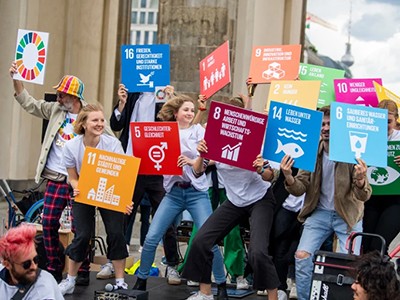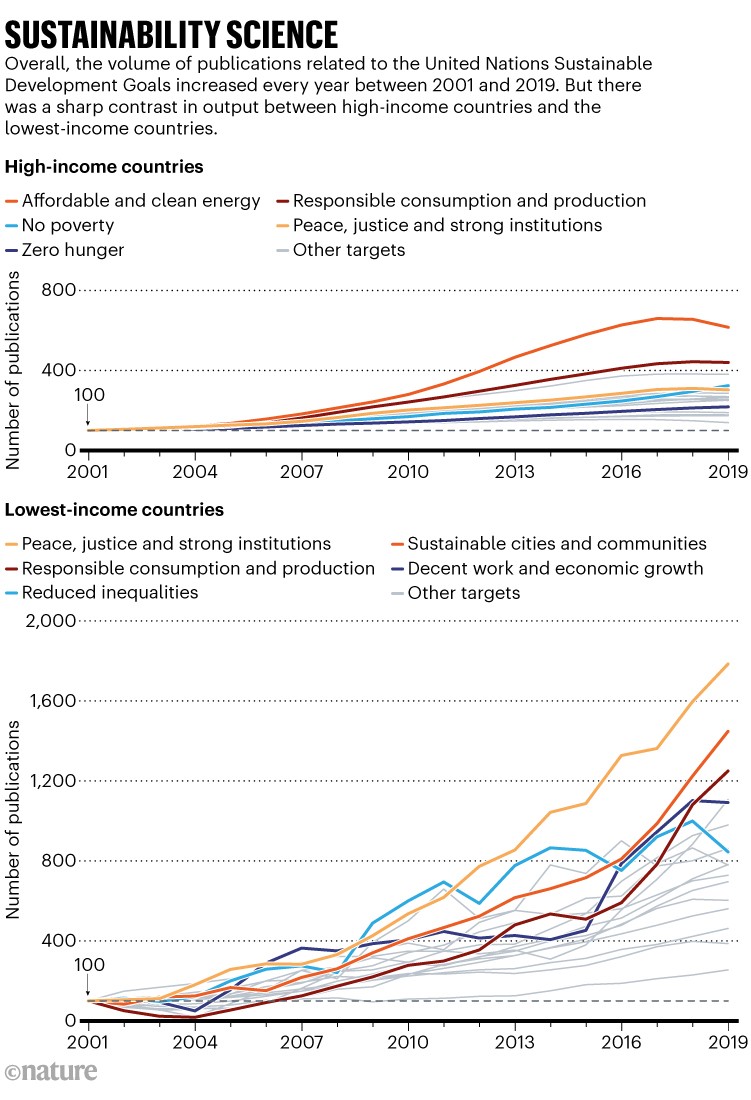Between now and September, Nature will be publishing a special series of editorials covering each of the 17 Sustainable Development Goals.Credit: Stanislav Kogiku/SOPA Images/LightRocket via Getty
Many people would be unable to name even one of the 17 United Nations Sustainable Development Goals (SDGs), which are at the heart of an international project that aims to end poverty and achieve equality while protecting the environment. From this week, to help raise awareness, we at the Nature Portfolio journals will intensify our ongoing efforts to publish research and commentary on the SDGs.
The SDGs and their 169 associated targets are among humanity’s best chance of dealing with global crises, from climate change to economic hardship. World leaders agreed the goals in 2015 and set a 2030 deadline to achieve them. This year, at the half-way point, it looks likely that none of the goals and just 12% of the targets will be met.
In September, world leaders will gather in New York City to come up with a rescue plan. And between now and then, Nature will be publishing a series of editorials focusing on the different SDGs, covering what has and hasn’t been achieved, what can be done to improve matters, and the part the global scientific community has to play.
The failure to meet even one of the SDGs is not for want of trying. Worldwide, researchers have been aligning their work with the SDGs, along with other global efforts such as UN conventions on climate change and biodiversity loss. Unfortunately, fracturing geopolitics is hindering international cooperation. In addition, there is limited cooperation and coordination across topics and between disciplines.
There is a need to give more consideration to complementarities and trade-offs between the different SDGs. For example, action to develop affordable and clean energy (SDG7) to tackle climate change (SDG13) can have negative local effects on biodiversity (SDGs 14 and 15) through the construction and operation of facilities such as wind and solar farms. And although finance for coal-fired power is an effective way to create work and economic growth (SDG8), it is bad news for health and well-being (SDG3), as well as for the environment. The knowledge of these trade-offs is often given insufficient consideration in policymaking.

Do the science on sustainability now
Last week, an independent group of science advisers to the UN proposed a way forwards. Their 2023 Global Sustainable Development Report (GSDR) summarizes where the SDGs are failing, and what can be done to rescue them. It reiterates the need for transformational change to get the world onto a sustainable path. Crucially, it recognizes the interconnectedness of the goals and targets.
Like its predecessor, published in 2019, the report recategorizes the SDGs into six “entry points”: human well-being and capabilities; sustainable and just economies; sustainable food systems and healthy nutrition patterns; energy decarbonization with universal access; urban and peri-urban development; and global environmental commons. To progress on human well-being, for example, the report recommends scaling up investment in primary health care and ensuring access to lifesaving interventions; accelerating enrolment in secondary education; and increasing investment in water and sanitation infrastructure.
The authors recognize that the path to sustainability must also include abolishing unsustainable practices, while taking into account the economic and social pain that this can cause. For example, increasing the availability of renewable energy won’t, on its own, tackle climate change: fossil fuels must also be phased out. As we wrote last week (Nature 618, 433; 2023), there is active resistance to this move and a genuine need to support affected communities, such as those that have relied on the coal industry for decades. Such scenarios don’t apply only to reaching energy and climate goals.
The GSDR represents welcome progress on the ‘what’ of meeting the SDGs. It also proposes what to do on the ‘how’. The necessary transformations will be expensive, the authors say — requiring extra annual public and private investment of up to US$2.5 trillion. For efforts to succeed, new ways of governing will be required, with the creation of new institutions and the reform of old ones to put sustainability front and centre. Individual and collective action of the kind already under way will also be needed, but on a bigger scale. And people must be given the right resources and skills to complete the task. This will be especially important in low- and middle-income countries (LMICs).
Implicit — and to a degree explicit — in all this is changing how science itself is done. The report argues that the actions that steer the world towards a sustainable path must be rooted in science that is multidisciplinary, equitable and inclusive, openly shared and widely trusted, and “socially robust” — in short, responsive to social context and social needs. As the authors acknowledge, for that to happen, global science needs to evolve. Knowledge needs to be more accessible than it is at present, and the production of that knowledge needs to be more open, too, recognizing, for example, the value of Indigenous and local knowledge to sustainable innovation.
We know from a separate UN study published in 2021 that science in LMICs is already much more aligned with the SDGs than is science in high-income countries. And LMICs have published a much higher volume of research relating to the SDGs (see ‘Sustainability science’). The challenge is how to improve the situation in high-income nations. Widespread improvement would be truly game-changing for sustainability.

Adapted from: Changing Directions: Steering Science, Technology and Innovation towards the Sustainable Development Goals
That’s where we’ll take our cue. We’ll assess the evidence and talk to researchers about the state of play on the SDGs, and explore questions that researchers can help to answer. Right now, a sustainable future remains as far away as ever. If there’s even a small chance that we can still achieve the SDGs by 2030, we need to seize it with both hands. As so many have already said, there is no planet B.
Credit:Source link




